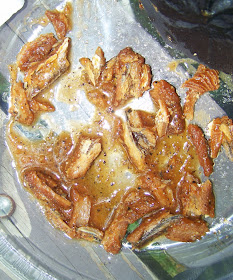 I bet your mouth is watering right now! This is sardines mashed up. Smells yucky, looks gross, but the kids actually said it wasn't bad at all.
I bet your mouth is watering right now! This is sardines mashed up. Smells yucky, looks gross, but the kids actually said it wasn't bad at all. 

 Looks gross doesn't it? But deceit and trickery is part of the game, too. Some thought this was worms, some thought squid tentacles. But really is is just oriental mushrooms. One of the kids passed and gave the other team a point on this one. Just looked too awful to eat. Of course I was going on about how sorry I was that they had picked it. What a stinker, I am!
Looks gross doesn't it? But deceit and trickery is part of the game, too. Some thought this was worms, some thought squid tentacles. But really is is just oriental mushrooms. One of the kids passed and gave the other team a point on this one. Just looked too awful to eat. Of course I was going on about how sorry I was that they had picked it. What a stinker, I am!This is eel. And it actually was not bad at all. The kids took this plate to lunch with them and finished it off and wondered where they could get more. I was really surprised.
Liver pate'. Smelled like cat food. Nuff said.
 Yes, those are what you think they are. Crickets. We buy them from a specialty store that carries flavored bugs. These are bacon and cheese flavored.
Yes, those are what you think they are. Crickets. We buy them from a specialty store that carries flavored bugs. These are bacon and cheese flavored.  What is this??? Actually, the ingredients are simple: Bean dip, cottage cheese and pickle relish.
What is this??? Actually, the ingredients are simple: Bean dip, cottage cheese and pickle relish.This was another psych out.
And the grossest of the gross. Squid in natural ink. Very, very, very, very, very disgusting.

Our teams had a tie, so a tie-breaker was in order. Miss Linsi made a lovely hors d'oeuvres for a challenge. The contestants scarfed it down like it was nothing. Unreal! So they ended in a tie-both teams were winners in this contest. And now I need to come up with something a little more challenging for the next Survivor Camp!



 Here is the little guy. I jumped out of the car at my place and clicked a bunch of pictures. I heard the neighbor kids wonder out loud what I was doing and soon they sent a scout to wander by and take a peek. I heard the report in the distance-"She is taking pictures of a bug, eeewwww!"
Here is the little guy. I jumped out of the car at my place and clicked a bunch of pictures. I heard the neighbor kids wonder out loud what I was doing and soon they sent a scout to wander by and take a peek. I heard the report in the distance-"She is taking pictures of a bug, eeewwww!"

 My cat Peach shoved her body THROUGH the blind to let me know she was quite annoyed with the whole thing. "Why are you out there looking at a bug and not in here taking care of me? I want nums!!!"
My cat Peach shoved her body THROUGH the blind to let me know she was quite annoyed with the whole thing. "Why are you out there looking at a bug and not in here taking care of me? I want nums!!!"
 The snakes are measured from their head to their vent or cloaca (where they poo, for my non-sciencey friends). This is
The snakes are measured from their head to their vent or cloaca (where they poo, for my non-sciencey friends). This is 
 Here is a pic to show how small the pit-tags are. They are the small copper colored pellets. Notice how tiny they are when compared to the pencil.
Here is a pic to show how small the pit-tags are. They are the small copper colored pellets. Notice how tiny they are when compared to the pencil.
 The microchip is inserted just under the skin of the snake with a syringe.
The microchip is inserted just under the skin of the snake with a syringe. The snakes are marked so we will know which ones have already been captured. This mark is not permanent; it will disappear when the snake sheds its skin.
The snakes are marked so we will know which ones have already been captured. This mark is not permanent; it will disappear when the snake sheds its skin.
 Here is Andrew Moore, a student of Dr. Rich King showing his skills.
Here is Andrew Moore, a student of Dr. Rich King showing his skills. This is one of the big boys, or more accurately, girls. The female snakes are usually bigger than the males. What a whopper!
This is one of the big boys, or more accurately, girls. The female snakes are usually bigger than the males. What a whopper!



 Bold Jumping Spider can be distinguished by its dull black spots on its abdomen. There are many different phases and colors of this spider and you can view another one that is more of a brown phase on
Bold Jumping Spider can be distinguished by its dull black spots on its abdomen. There are many different phases and colors of this spider and you can view another one that is more of a brown phase on 
